This site uses cookies as defined in our Cookie Policy, by continuing to use this site you agree to their use.
Continue
| Arrive | Depart | ||||||
| 17th17 | AprApr | 202727 | Miami, Florida, United States, embark on the Zuiderdam | 17:00 | |||
Miami is one of the world’s most popular holiday spots. It has so much to offer; from its countless beach areas, to culture and museums, from spa and shopping days out, to endless cuban restaurants and cafes. Miami is a multicultural city that has something to offer to everyone. | |||||||
| 18th18 | AprApr | 202727 | At Sea | ||||
| 19th19 | AprApr | 202727 | At Sea | ||||
| 20th20 | AprApr | 202727 | Kings Wharf, Bermuda | 08:00 | 17:00 | ||
You go to heaven if you want - I'd rather stay here in Bermuda!' So gushed Mark Twain in the 19th century, and Bermuda's promise of sun and sea still lures holiday-makers to its shores. Settled by the English Virginia Company in 1609, Bermuda is the oldest and most populous of Britain's remaining overseas territories. These days, celebrities like Michael Douglas and Catherine Zeta-Jones call Bermuda home. The island is surrounded by a fantastic coral reef that harbours colourful fish and has ensnared scores of shipwrecks, making for memorable diving and snorkelling. | |||||||
| 21st21 | AprApr | 202727 | At Sea | ||||
| 22nd22 | AprApr | 202727 | At Sea | ||||
| 23rd23 | AprApr | 202727 | At Sea | ||||
| 24th24 | AprApr | 202727 | At Sea | ||||
| 25th25 | AprApr | 202727 | At Sea | ||||
| 26th26 | AprApr | 202727 | At Sea | ||||
| 27th27 | AprApr | 202727 | At Sea | ||||
| 28th28 | AprApr | 202727 | Falmouth, England | 08:00 | 17:00 | ||
The bustle of this resort town's fishing harbor, yachting center, and commercial port only adds to its charm. In the 18th century Falmouth was the main mail-boat port for North America, and in Flushing, a village across the inlet, you can see the slate-covered houses built by prosperous mail-boat captains. A ferry service now links the two towns. On Custom House Quay, off Arwenack Street, is the King's Pipe, an oven in which seized contraband was burned. | |||||||
| 29th29 | AprApr | 202727 | Le Havre, France | 08:00 | 18:00 | ||
Le Havre, founded by King Francis I of France in 1517, is located inUpper Normandy on the north bank of the mouth of the River Seine, which isconsidered the most frequented waterway in the world. Its port is ranked thesecond largest in France. The city was originally built on marshland andmudflats that were drained in the 1500’s. During WWII most of Le Havre wasdestroyed by Allied bombing raids. Post war rebuilding of the city followed thedevelopment plans of the well-known Belgian architect Auguste Perre. Thereconstruction was so unique that the entire city was listed as a UNESCO WorldHeritage Site in 2005. | |||||||
| 30th30 | AprApr | 202727 | Zeebrugge, Belgium | 09:00 | 17:00 | ||
In 1895 work began to construct a new seaport and harbour next to the tiny village of Zeebrugge, situated on the North Sea coast. Today the fast-expanding port of Zeebrugge is one of the busiest in Europe and its marina is Belgium’s most important fishing port. Many attempts were made to destroy this important port during both World Wars. Zeebrugge is ideally located for discovering the historic city of Bruges, and delightful seaside resorts with long sandy beaches can be visited by using the trams that run the whole length of the Belgian coast. Please note that no food may be taken ashore in Belgium. We shall not be offering shuttle buses to Bruges, but you may visit the city on an optional excursion: those visiting Bruges should note that there may be quite a long walk from the coach to the town centre. | |||||||
| 1st01 | MayMay | 202727 | Amsterdam, Netherlands, disembark the Zuiderdam | 07:00 | |||
Amsterdam combines the unrivaled beauty of the 17th-century Golden Age city center with plenty of museums and art of the highest order, not to mention a remarkably laid-back atmosphere. It all comes together to make this one of the world's most appealing and offbeat metropolises in the world. Built on a latticework of concentric canals like an aquatic rainbow, Amsterdam is known as the City of Canals—but it's no Venice, content to live on moonlight serenades and former glory. Quite the contrary: on nearly every street here you'll find old and new side by side—quiet corners where time seems to be holding its breath next to streets like neon-lit Kalverstraat, and Red Light ladies strutting by the city's oldest church. Indeed, Amsterdam has as many lovely facets as a 40-carat diamond polished by one of the city's gem cutters. It's certainly a metropolis, but a rather small and very accessible one. Locals tend to refer to it as a big village, albeit one that happens to pack the cultural wallop of a major world destination. There are scores of concerts every day, numerous museums, summertime festivals, and, of course, a legendary year-round party scene. It's pretty much impossible to resist Amsterdam's charms. With 7,000 registered monuments, most of which began as the residences and warehouses of humble merchants, set on 160 man-made canals, and traversed by 1,500 or so bridges, Amsterdam has the largest historical inner city in Europe. Its famous circle of waterways, the grachtengordel, was a 17th-century urban expansion plan for the rich and is a lasting testament to the city’s Golden Age. This town is endearing because of its kinder, gentler nature—but a reputation for championing sex, drugs, and rock ’n’ roll does not alone account for Amsterdam's being one of the most popular destinations in Europe: consider that within a single square mile the city harbors some of the greatest achievements in Western art, from Rembrandt to Van Gogh. Not to mention that this is one of Europe's great walking cities, with so many of its treasures in the untouted details: tiny alleyways barely visible on the map, hidden garden courtyards, shop windows, floating houseboats, hidden hofjes(courtyards with almshouses), sudden vistas of church spires, and gabled roofs that look like so many unframed paintings. And don’t forget that the joy lies in details: elaborate gables and witty gable stones denoting the trade of a previous owner. Keep in mind that those XXX symbols you see all over town are not a mark of the city's triple-X reputation. They're part of Amsterdam's official coat of arms—three St. Andrew's crosses, believed to represent the three dangers that have traditionally plagued the city: flood, fire, and pestilence. The coat's motto ("Valiant, determined, compassionate") was introduced in 1947 by Queen Wilhelmina in remembrance of the 1941 February Strike in Amsterdam—the first time in Europe that non-Jewish people protested against the persecution of Jews by the Nazi regime. | |||||||
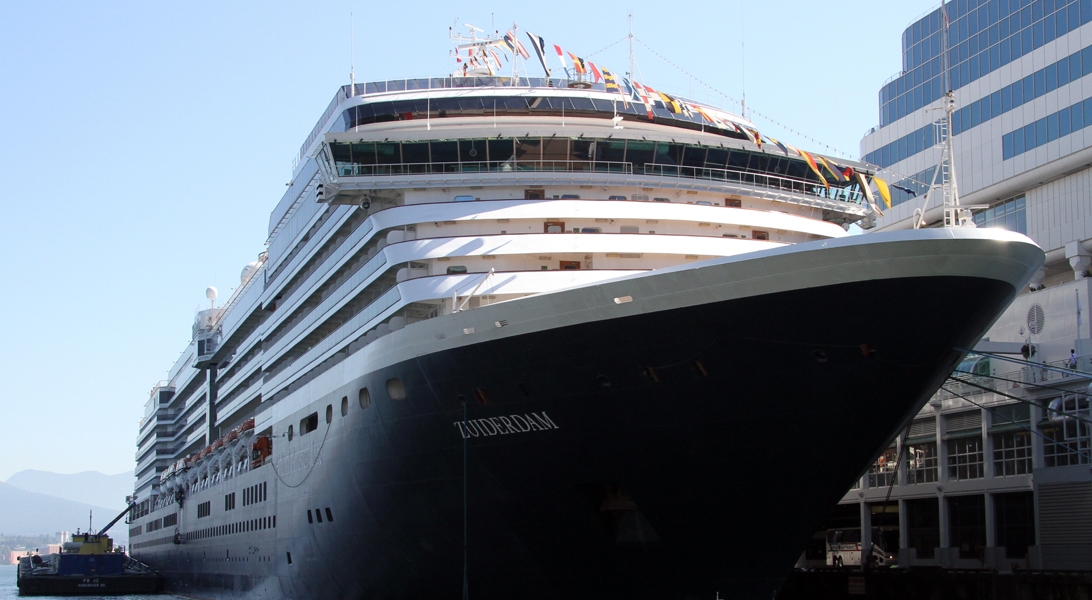
The images shown are for illustration purposes only and may not be an exact representation of what you find on the ship.
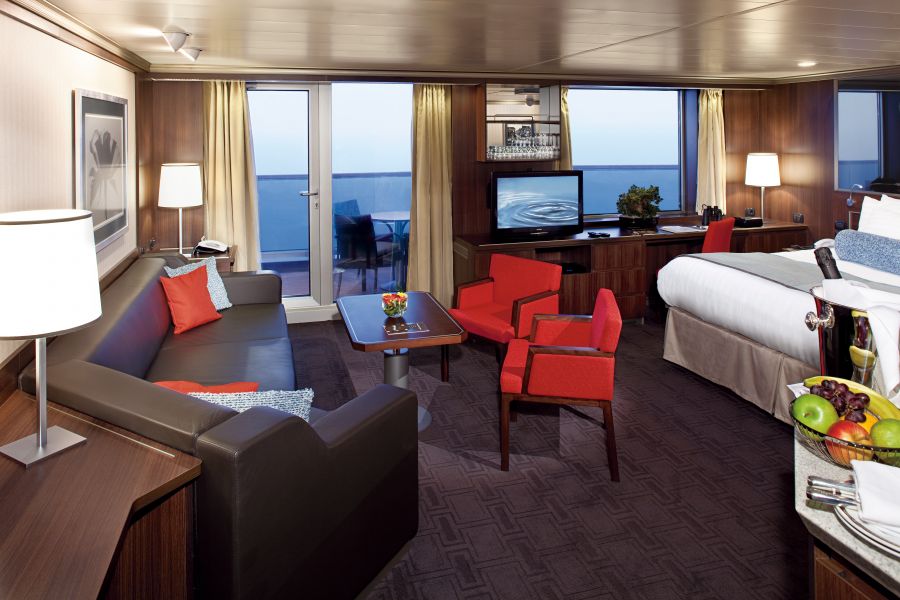
| Grade Code | From | To | |
| SC | Neptune Suite | £4,969 | £4,969 |
| SB | Neptune Suite | £5,449 | £5,449 |
| SA | Neptune Suite | £5,929 | £5,929 |
With floor-to-ceiling windows overlooking a private verandah, these spacious suites are flooded with light. They feature a large sitting area and two lower beds convertible to one king-size bed—our signature Mariner's Dream™ bed with plush Euro-Top mattresses plus a separate dressing room. There's also a sofa bed, suitable for two people. The bathroom comes with a dual-sink vanity, full-size whirlpool bath and shower, plus additional shower stall. Amenities include use of the exclusive Neptune Lounge, a private concierge and an array of complimentary services.
The configuration of staterooms may vary from the images shown.
Approximately 500–712 sq. ft. including verandah
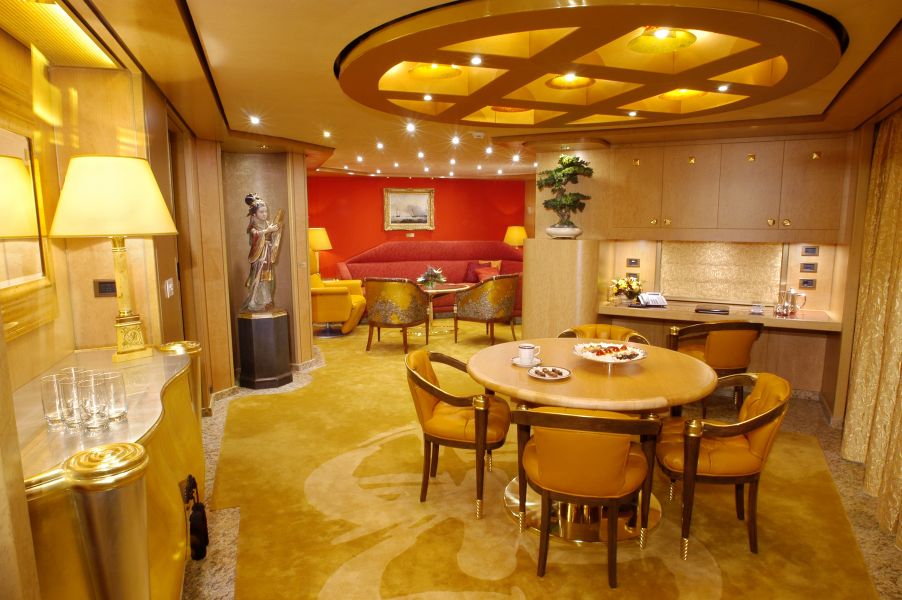
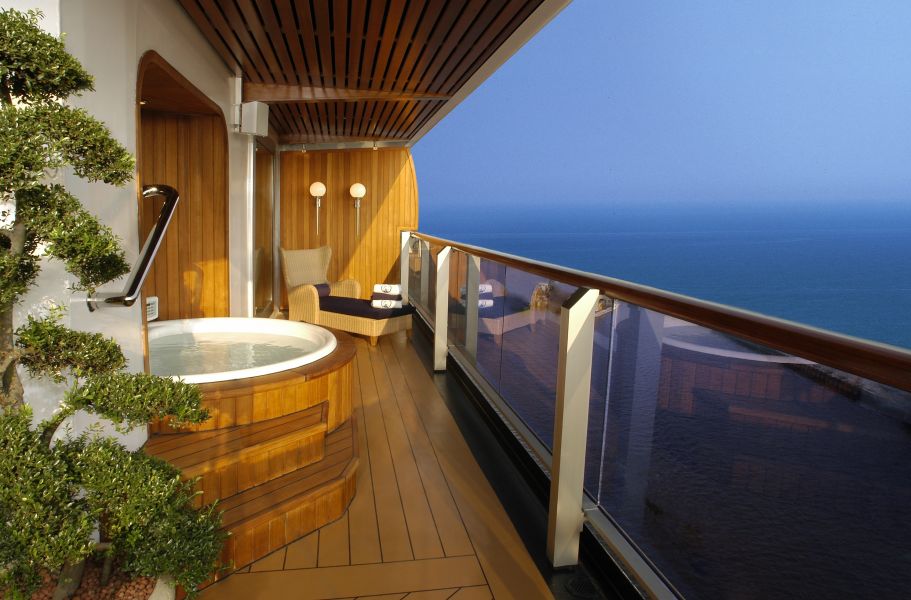
| Grade Code | From | To | |
| PS | Pinnacle Suite | £8,839 | £8,839 |
Generously proportioned and filled with light, these elegant suites include a living room, dining room, pantry with microwave and refrigerator, and floor-to-ceiling windows overlooking a private verandah with whirlpool. The bedroom features a king-size bed—our Signature Mariner's Dream™ bed with plush Euro-Top mattresses, plus a separate dressing room and the bath includes an oversize whirlpool bath and shower as well as an additional shower stall. There's also a sofa bed, suitable for two people, and a guest toilet. Amenities include a private stereo system, use of the exclusive Neptune Lounge, private concierge and an array of complimentary services.
The configuration of staterooms may vary from the images shown.
Approximately 1,150 sq. ft. including verandah
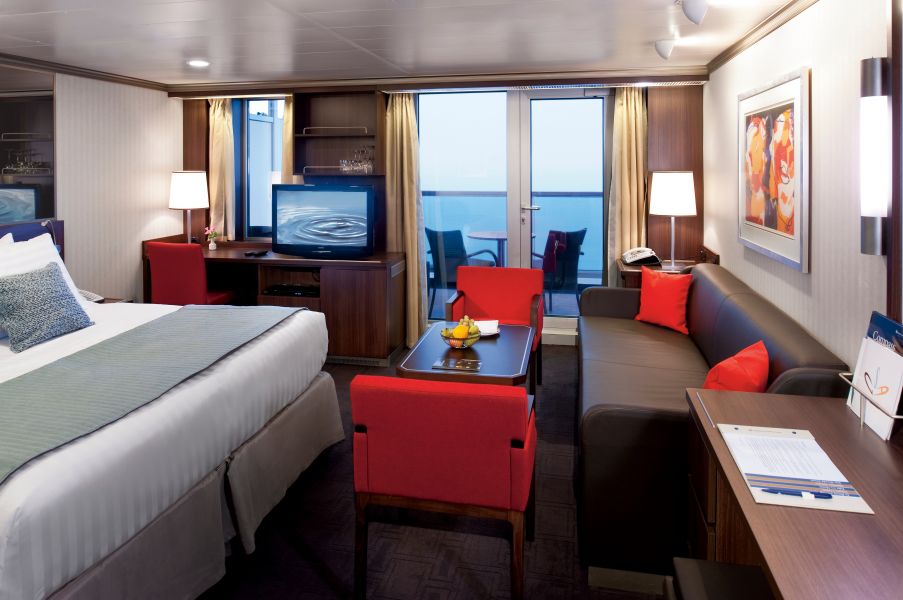
| Grade Code | From | To | |
| SZ | Signature Suite | £3,149 | £3,149 |
| SY | Signature Suite | £3,389 | £3,389 |
| SS | Signature Suite | £3,629 | £3,629 |
These large, comfortable suites feature a spacious sitting area with floor-to-ceiling windows overlooking a private verandah, two lower beds convertible to one queen-size bed—our signature Mariner's Dream™ bed with plush Euro-Top mattresses, and one sofa bed for one person. The bathroom includes a dual-sink vanity, full-size whirlpool bath and shower, and an additional shower stall.
The configuration of staterooms may vary from the images shown.
Approximately 372–384 sq. ft. including verandah
The images shown are for illustration purposes only and may not be an exact representation of what you find on the ship.

At Explorations Café, sink into plush chairs and sofas in a comfortable environment. Sip elegantly prepared espresso drinks and nosh on fresh pastries from the coffee bar. You can also take in fantastic views, catch up on your favourite book or browse the web.

Pinnacle Grill is the ultimate steakhouse at sea, where an exceptional menu and impeccable service make for one of finest meals you’ll ever have. The refined menu features a selection of 28-day wet-aged USDA Prime steaks — meticulously chosen to guarantee the finest quality — as well as classic steakhouse dishes and innovative recipes from James Beard Award-winning chef and Culinary Council® member, David Burke. Every dish is exquisitely prepared, beautifully plated and complemented by a vast collection of award-winning wines. Here, your meal is an event unto itself, a celebration of fine dining and a triumph of flavour.
The images shown are for illustration purposes only and may not be an exact representation of what you find on the ship.
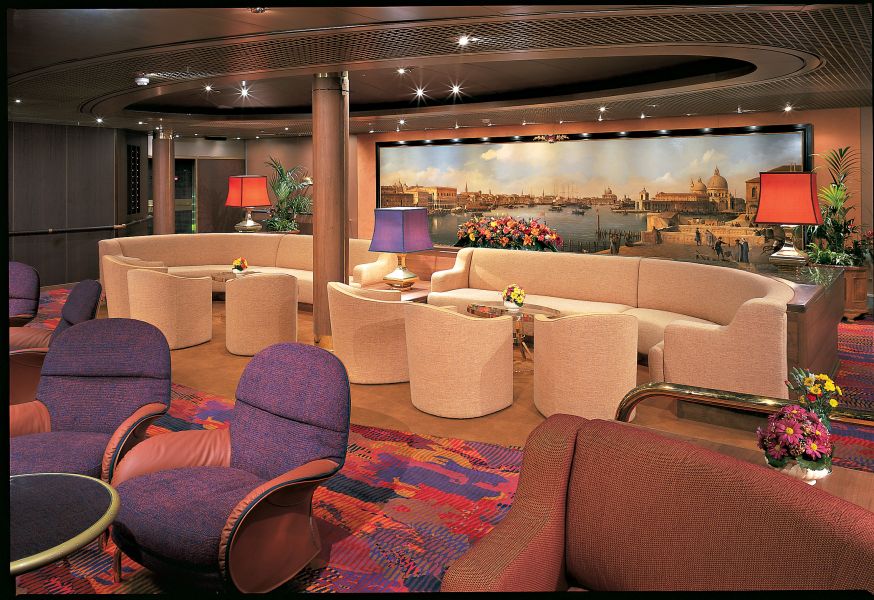
The Explorer’s Lounge is an elegant and refined space to enjoy a glass of wine, a cocktail, or your favorite liqueur.
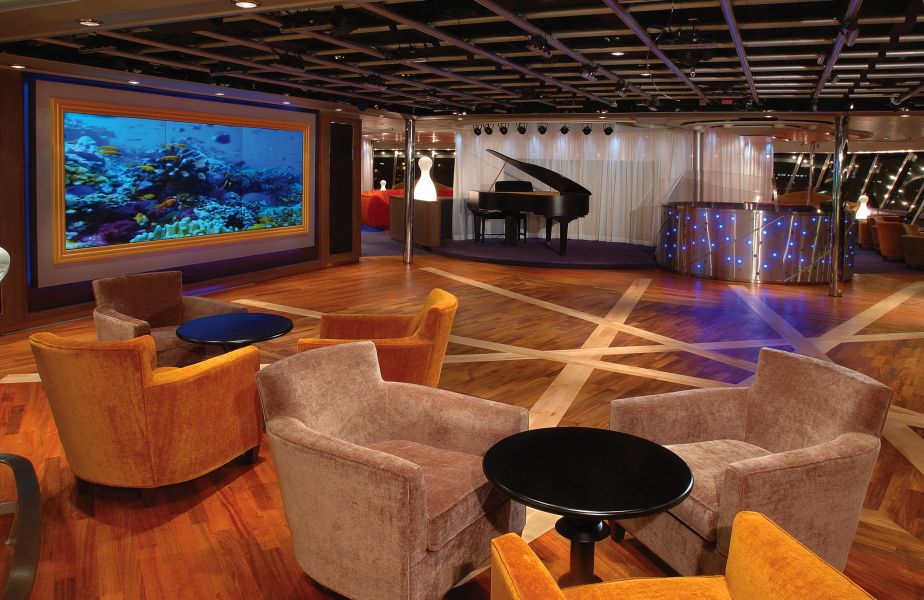
Holland America Line offers you a wide selection of lounges onboard. The panoramic view takes center stage in The Crow's Nest at the top of the ship, where you can relax just about any time of day and enjoy your favorite drink.
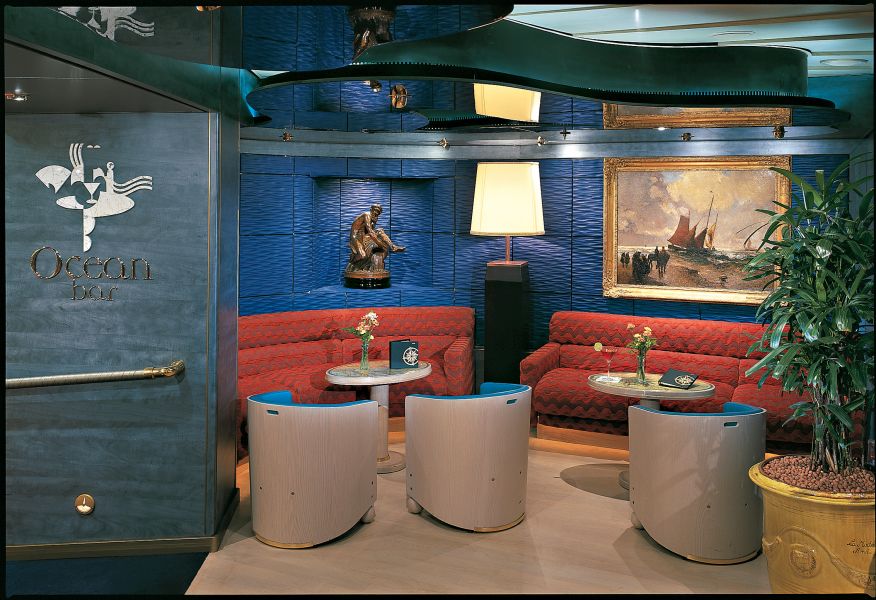
Enjoy live music in this popular bar perfect for pre-dinner cocktails.
The images shown are for illustration purposes only and may not be an exact representation of what you find on the ship.
The images shown are for illustration purposes only and may not be an exact representation of what you find on the ship.
| 14 nights aboard the Zuiderdam | |||
| Daily afternoon tea | |||
| Evening entertainment & theatre shows | |||
| Live Music venues inc. BB King's Blues Club | |||
| Live onboard cooking shows & workshops | |||
| Speciality Restaurants (charges may apply) | |||
| Drinks packages available | |||
| 24-hour room service | |||
| Port Taxes and Fees | |||
 | ABTA and ATOL Protection* | ||
Date 17th Apr 2027 |
Nts 14 |
Interior £1,739pp |
Oceanview £1,819pp |
Balcony £2,049pp |
Suite £3,149pp |
Date 17th Apr 2027 |
Nts 14 |
Interior £1,739pp |
Oceanview £1,819pp |
Balcony £2,049pp |
Suite £3,149pp |
| Interior staterooms from | £1,739pp | ||
| I | Large Interior Stateroom | £1,949pp | |
| J | Large Interior Stateroom | £1,919pp | |
| K | Large Interior Stateroom | £1,889pp | |
| L | Interior Stateroom | £1,859pp | |
| M | Interior Stateroom | £1,819pp | |
| MM | Interior Stateroom | £1,789pp | |
| N | Interior Stateroom | £1,739pp | |
| Oceanview staterooms from | £1,819pp | ||
| C | Ocean View Stateroom | £2,139pp | |
| D | Ocean View Stateroom | £2,099pp | |
| DD | Ocean View Stateroom | £2,059pp | |
| E | Ocean View Stateroom | £2,019pp | |
| F | Ocean View Stateroom | £1,939pp | |
| G | Ocean View Stateroom (May be Partial View) | £1,939pp | |
| H | Ocean View Stateroom (Obstructed) | £1,899pp | |
| HH | Ocean View Stateroom (Obstructed) | £1,819pp | |
| Balcony staterooms from | £2,049pp | ||
| VA | Verandah Stateroom | £2,559pp | |
| VB | Verandah Stateroom | £2,479pp | |
| VC | Verandah Stateroom | £2,399pp | |
| VD | Verandah Stateroom | £2,319pp | |
| VE | Verandah Stateroom | £2,239pp | |
| VF | Verandah Stateroom | £2,139pp | |
| VH | Verandah Stateroom | £2,049pp | |
| Suite staterooms from | £3,149pp | ||
| SA | Neptune Suite | £5,929pp | |
| SB | Neptune Suite | £5,449pp | |
| SC | Neptune Suite | £4,969pp | |
| SS | Signature Suite | £3,629pp | |
| SY | Signature Suite | £3,389pp | |
| SZ | Signature Suite | £3,149pp | |
| PS | Pinnacle Suite | £8,839pp | |
Fusion Cruises when selling travel arrangements is a trading name of The Midcounties Co-operative Ltd. Fusion Cruises is an Accredited Body Member of Midcounties Co-operative Travel Consortium. (ABTA:P6652, ATOL:6053).
Book with Confidence. We are a Member of ABTA which means you have the benefit of ABTA’s assistance and Code of Conduct.
Some of the flights and flight-inclusive holidays on this website are financially protected by the ATOL scheme but ATOL protection does not apply to all holiday and travel services offered on this website. This website will provide you with information on the protection that applies in the case of each holiday and travel service offered before you make your booking. If you do not receive an ATOL Certificate then the booking will not be ATOL protected. If you do receive an ATOL Certificate but all parts of your trip are not listed on it, those parts will not be ATOL protected. Please see our booking conditions for information, or for more information about financial protection and the ATOL Certificate go to: www.caa.co.uk
